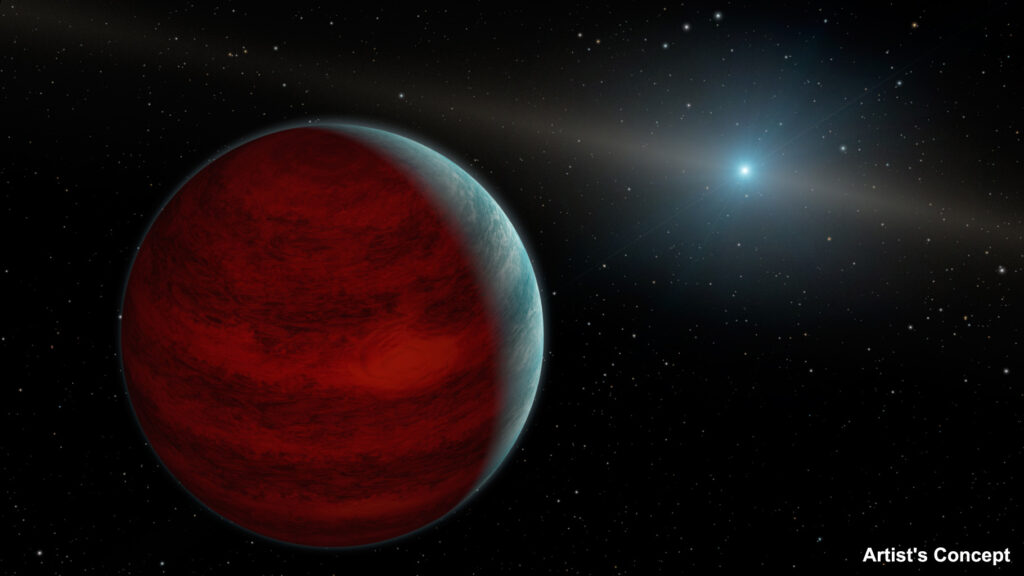
Introduction
WD 1856 b is a gas giant planet that most likely survived being engulfed by it’s star during it’s red giant phase. The idea is based on two studies done by F. Lagos et. al. 2020 and L. Chamandy et.al. 2020.
In both studies, the scientists found that massive gas giant planets are more robust than previously thought. Due to their strong gravity, they can survive inside their stars without evaporating. More surprising still, such planets can alter their star’s evolution and effectively determine the mass of the resulting white dwarf.
Lagos’ and Chamandy’s team found that this could explain conflicts regarding WD 1856’s age and the part of the Milky Way that it seems to belong to.
The WD 1856 star system
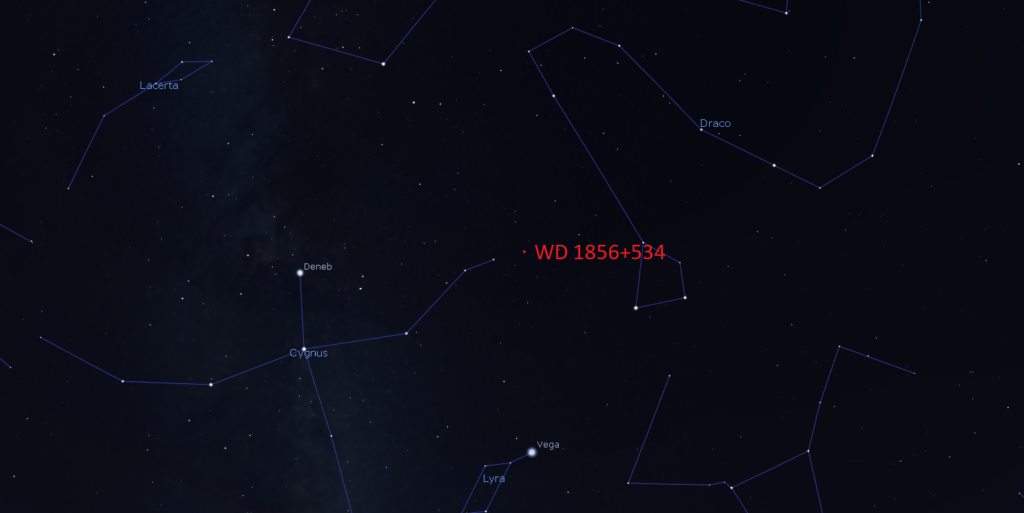
WD 1856+534 is located 80 light years away between the constellations of Cygnus and Draco. It consists of three stars. Two of the stars, G 229-20 A and B, are low mass red dwarfs. The other star, WD 1856, is a white dwarf.
The red dwarfs orbit one another while orbiting the white dwarf in a very wide orbit. The white dwarf has cool down considerably. It’s temperature on it’s surface is only 4700 K (4430 C or 6000 F) which is cooler than the Sun’s surface temperature of 5778 K (5505 C or 9941 F). It’s mass is around 51.8% that of the Sun.
In 2020, a study of data from the Transiting Exoplanet Survey Satellite (TESS) reveal a planet orbiting close to the white dwarf. Astronomers call this planet WD 1856 b. This is the first time we see a planet orbiting a solitary white dwarf. It is however, not the first discovered orbiting a white dwarf. Back in 1993, we discovered one planet, PSR B1620+26 b, orbiting a binary pair consisting of a white dwarf and a neutron star.
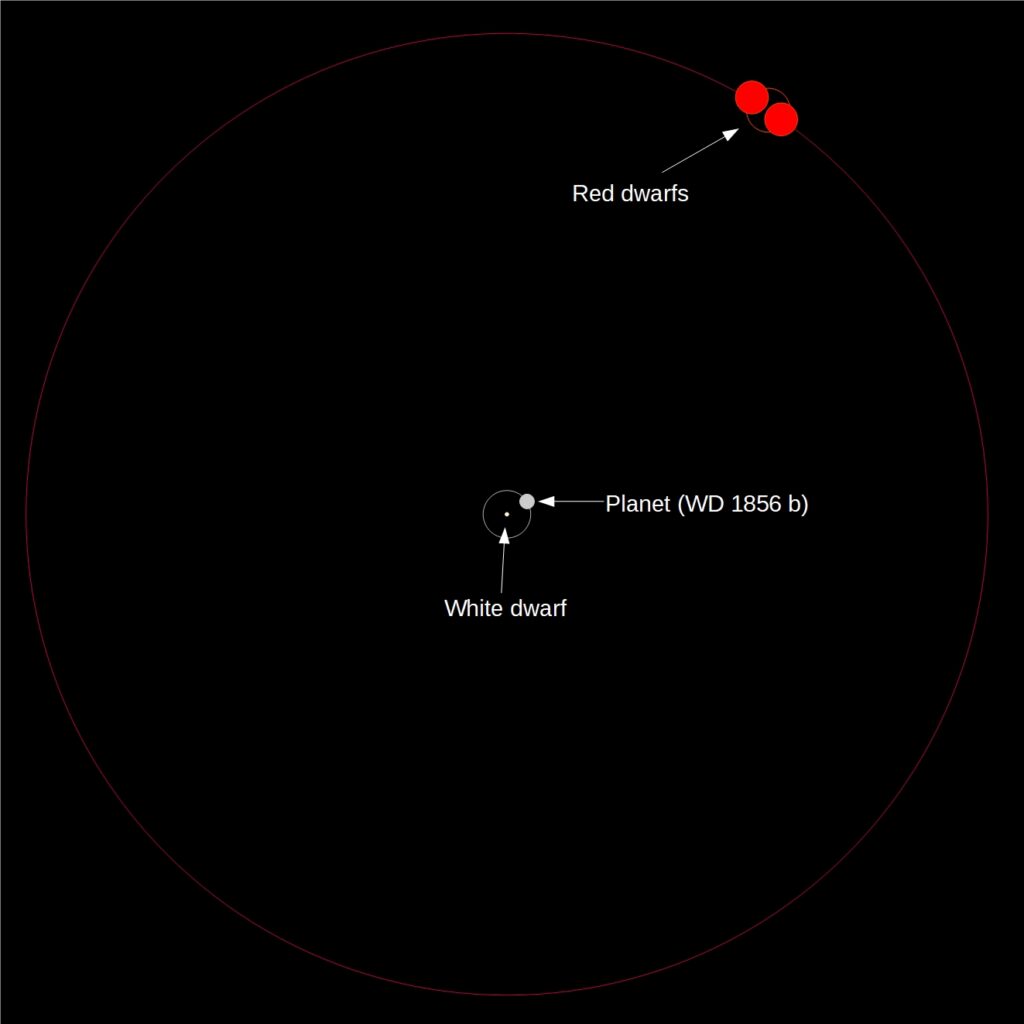
WD 1856 b: The planet
WD 1856 b appears to have a mass that is slightly less than 13.8 times the mass of Jupiter and has a radius of 92.8% that of Jupiter. The white dwarf on the other hand has a radius of 1.4 times Earth’s radius. This means the planet is 7 times larger than the white dwarf that it orbits.
The planet orbits around the white dwarf every 1.4 days at a distance of 0.02 AU away. This is 63 times faster than the closest planet to the sun, Mercury, which orbits every 88 days at a distance of 0.39 AU away. For reference, the distance between the Earth and Sun is 1 AU.
The astronomers that found the planet suggests it most likely formed far from it’s star. It then experienced gravitational interactions with undiscovered planets or the red dwarfs further out. This threw it into an elliptical orbit taking it close to it’s star. Once that happened, tidal interactions with the white dwarf caused the planet to enter a tight circular orbit.
As we shall see, this may not be the most likely explanation for how the planet got there.
WD 1856 is too old for it’s location
Recently, another team of astronomers published a paper (Lagos et. al. 2020). In there, they point out that WD 1856’s temperature and mass makes it likely more than 10 billion years old.
This is a big problem as WD 1856’s position and velocity shows it is part of the thin disk of the Milky Way. According to the accepted model of galaxy formation, the Milky Way’s thin disk can only be 10 billion years old.
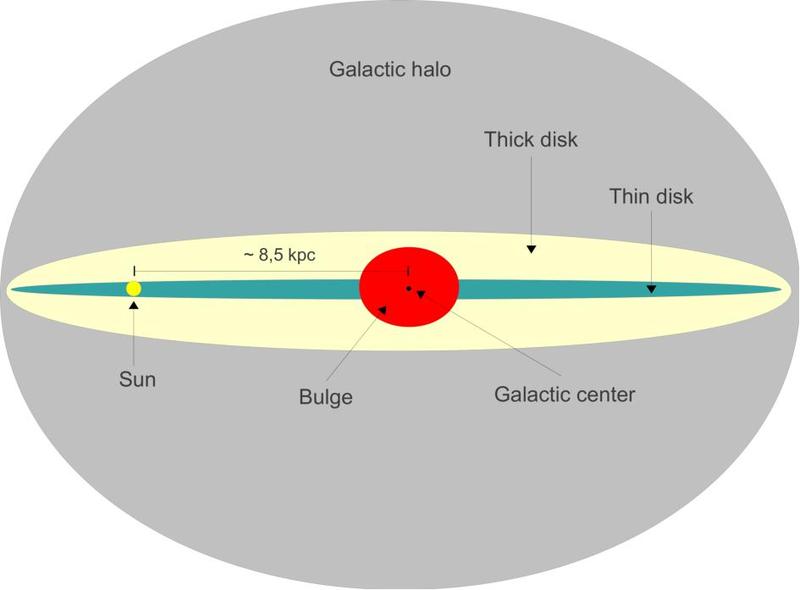
According to Lagos’ team, this problem can be resolved if WD 1856 were not as old as it’s temperature and mass would indicate. One way that this could happen is that WD 1856 could have engulfed it’s planet, WD 1856 b, when it was a red giant.
Lagos’ team reasoned that this would have stop WD 1856’s core (the future white dwarf) from growing as massive as it would have. This is because the planet’s orbital motion would prematurely strip away the star’s outer layers. Thus shortening it’s giant phase and stopping the core from becoming more massive resulting in a smaller white dwarf.
This would mean WD 1856 is much younger despite what it’s mass and temperature would imply.
Problems with WD 1856 b being a planet
Currently, most experts reject the idea that WD 1856 engulfed it’s planet during it’s red giant phase. According to some of them, this scenario is still possible but highly unlikely.
Many have pointed out that objects need to be very massive to survive being engulfed by stars. Often, such objects are themselves stars or brown dwarfs (objects heavier than planets but not massive enough to be stars).
The reason is similar to why light objects moving through air don’t move as far as heavy objects. This occurs even if they are of similar shape and size. One way to look at it is heavier objects have more kinetic energy for the same speed. It therefore takes more interaction with the air to slow it down.
The same goes for planets, brown dwarfs and stars engulfed by the star they orbit. We know that stars and brown dwarfs are massive enough to have lots of kinetic and gravitational potential energy to dissipate. Planets however do not have enough mass and thus energy. Therefore, they would spiral into the star’s core and be destroyed before all the outer layers are ejected.
Factors increasing survival
In response to the previous arguments, Lagos’ team argues that previous research used inadequate assumptions. Some of them did not take into account mass loss before the star engulfed the planet. This is really important as red giants experience lots of mass loss due to how weakly they hold on to their outer layers.
There is also the fact that many of the previous researchers based their models on assumptions that may not be true for all scenarios.
One of those assumptions is that the maximum size the star could expand to in it’s giant phase depends solely on it’s core mass. This would work for a single star that did not engulf any thing of significant mass which is not the case with WD 1856.
Help from another planet (WD 1856 c?)
It could be that WD 1856 originally had two planets. WD 1856 b being the outer planet. The inner planet could have helped eject some of the star’s outer layers before it came too close and evaporated or broke apart. This means the surviving planet, WD 1856 b, only needed to eject some of the outer layers to survive.
Chamandy et. al. 2020 explored this idea in greater detail. They cited past research that show that WD 1856 b by itself could have indeed ejected enough of it’s star’s outer layers. However, this only work if WD 1856’s original mass was 1.4 times that of the Sun. But this would result in a much lower mass white dwarf than WD 1856.

Bloating WD 1856
Lagos et. al. 2020 suggests that WD 1856 b may have orbited WD 1856 at a distance of 1.7 to 4 AU at the end the of the star’s main-sequence life. At the same time, the second planet would have started off orbiting somewhat closer to the star.
At that point, WD 1856 would have begun to expand into a sub-giant and then into a red giant. After this, it would shrink into a horizontal branch star when it’s core was hot enough to burn helium. Once the helium in it’s core has been used up, the star would expand again. This time, it would expand much bigger into an asymptotic giant branch (AGB) star.
For WD 1856 to have it’s current mass and temperature as a white dwarf, Chamandy et.al. 2020 showed that the star had to have an original mass between 1 and 3.5 solar masses. By analyzing the evolution of stars at these masses, Chamandy’s team calculated that the star would most likely have engulfed the inner planet during it’s AGB phase.
As the star’s outer layers approach the inner planet, it’s gravity begins to pull part of the star’s material into a disk around it. As more material encases the planet, it eventually becomes engulfed.
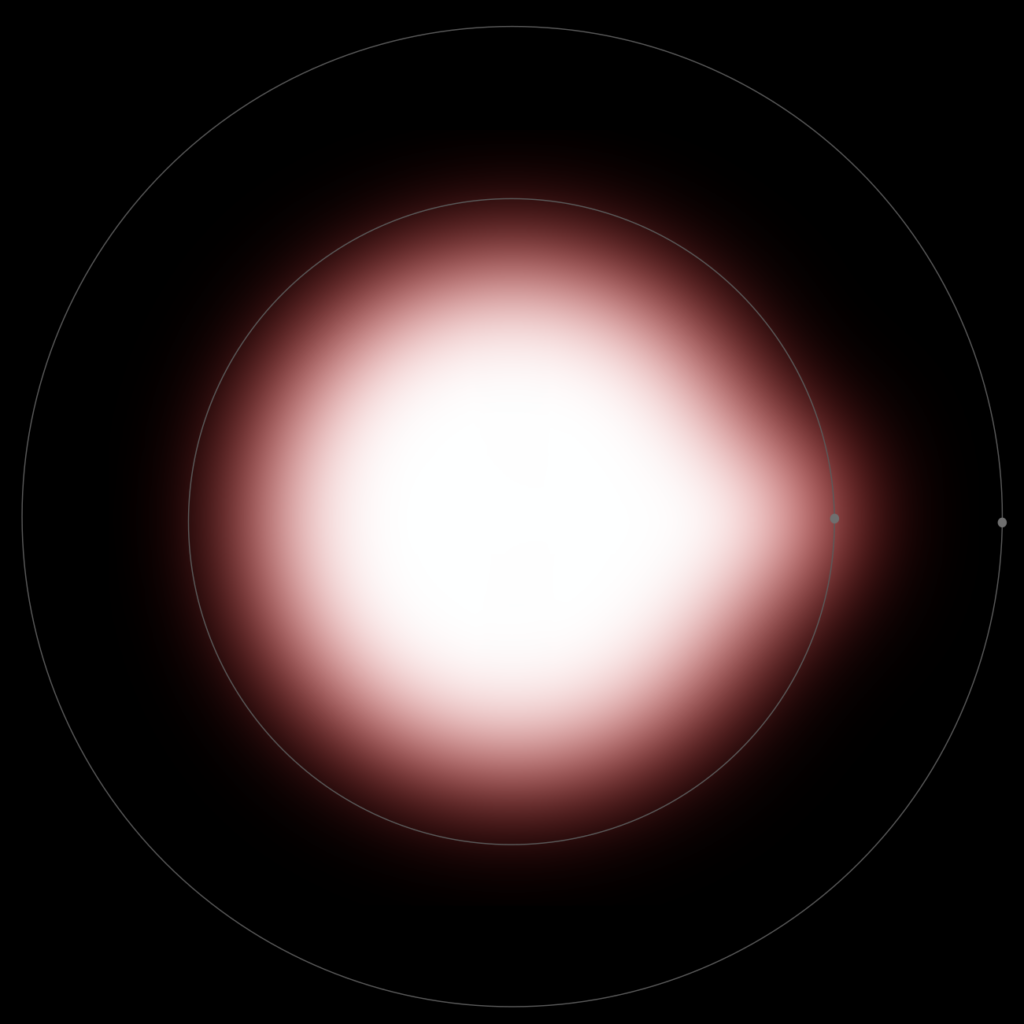
Dismantling the star from within
Once WD 1856’s outer layers completely engulf the inner planet, the planet starts to significantly change the star. These changes in turn would effect the outer planet, WD 1856 b.
As the planet orbits inside the star, it collides with the material in the star’s outer layers transferring it’s kinetic and gravitational potential energy to it. This causes the planet to spiral towards the star’s core.
At the same time, this causes the outer layers to heat up further. The extra heat causes them to evaporate more quickly and thus eject them into space. It also causes the star to expand further until it reaches the orbit of the outer planet. Like the inner planet, the outer planet starts pulling material from the star on to it. The planet also becomes engulfed and starts to spiral in and thus increase the star’s outer layer loss.
As the inner planet approaches the star’s core, Chamandy’s team predicts that one of two things could occur. The first is the planet makes it all the way to the core and merge with it. The second is tidal forces cause by the core’s gravity rips apart the planet. Either way, this does not change the future of the star and it’s remaining planet.
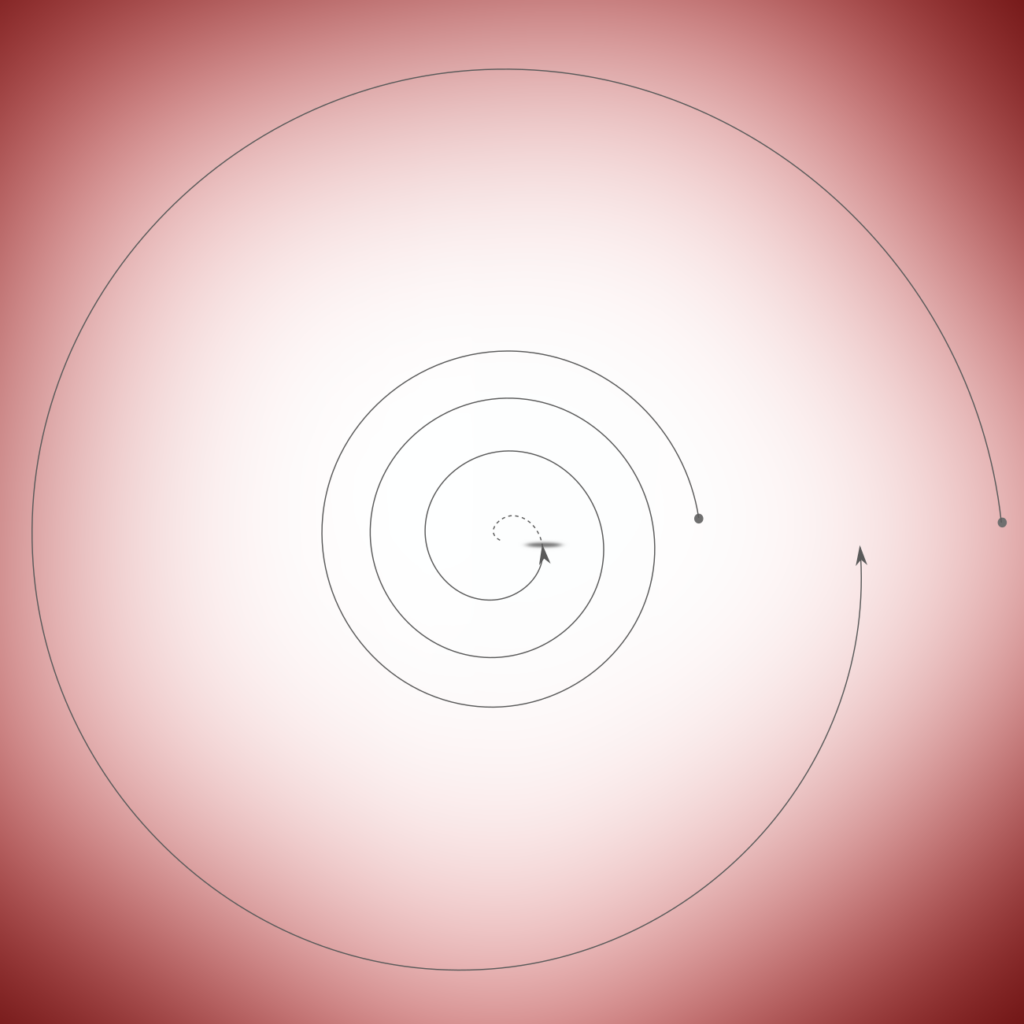
Settling around the white dwarf
With part of WD 1856’s outer layers ejected into space by the inner planet, the outer planet, WD 1856 b, has less material to deal with. Combined with thermal pulsations from the star’s core, the remaining planet ejects nearly all it’s star’s outer layers without meeting the same fate as the inner planet.
At this point, the planet, WD 1856 b, would be orbiting very close to WD 1856 which is now a white dwarf. Since the white dwarf is very young, it would be extremely hot. This meant that it would be emitting a lot of high energy UV radiation.
This UV radiation would cause the planet’s atmosphere to evaporate thus causing it to continue losing mass. We see this happen to planets around other white dwarfs such as WD J0914+1914 and WD 1145+017 due to the vaporized material blown off them.
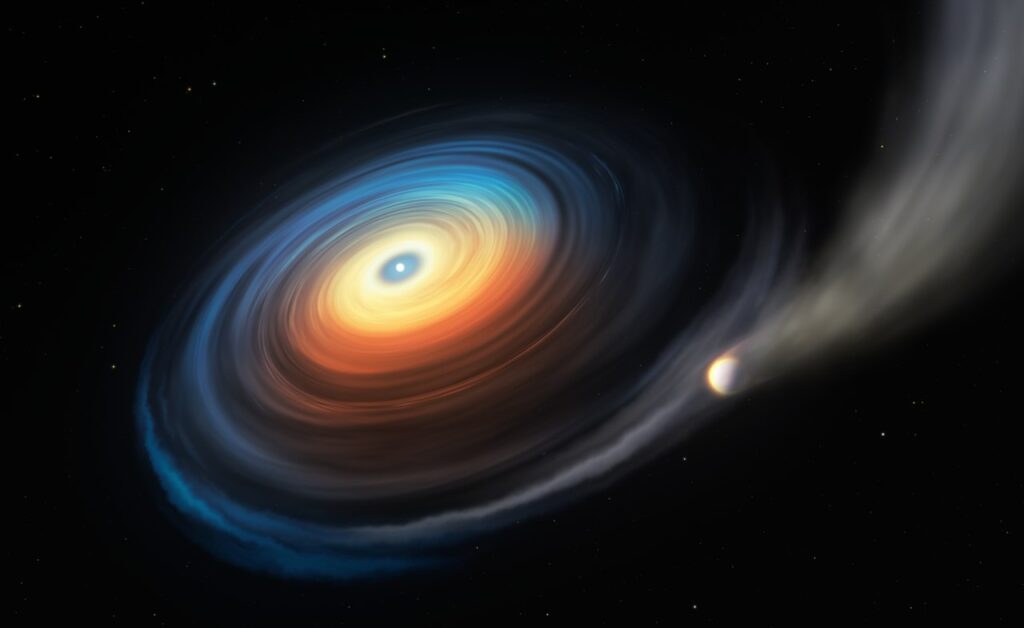
Eventually, WD 1856 would cool to a certain temperature. At that temperature, radiation from the white dwarf becomes too weak to cause the planet’s atmosphere to evaporate noticeably. Thus producing the system we see today.
Caveats with the model
Lagos et. al. 2020 and Chamandy et.al. 2020 argue that their model is the best at explaining WD 1856’s age and presence in the Milky Way’s thin disk along with it’s planet’s close orbit. However, they also state that this could change if further observations reveal the planet to be less massive. There could also be problems if WD 1856’s original mass turns out to be too small or too large.
If the planet turns out to be less than 5 times as massive as Jupiter, Lagos et. al. 2020’s idea of a single planet engulfed may not work. However, Chamandy et.al. 2020’s idea of a second planet closer in would still be possible.
Another point against the model is the presence of the binary red dwarfs orbiting further out. These along with a whole host of other factors such as galactic tides or passing stars could have flung the planet inwards to it’s current orbit. However as stated earlier, they cannot explain why WD 1856 is in the Milky Way’s thin disk which is only 10 billion years old despite the white dwarf itself appearing older than that.
Conclusion
The discovery and study of WD 1856 and other white dwarfs and neutron stars with planets and planetary remains have given us a clearer picture of what could happen to planets when their stars die. In doing so they also reveal surprises such as planets surviving engulfment by their star.

Over to you now. Do you think this was how WD 1856 and it’s planet came to be? If not, what do you think happened?
References
https://medium.com/amazing-science/the-fate-of-the-sun-dd8c857d22d8